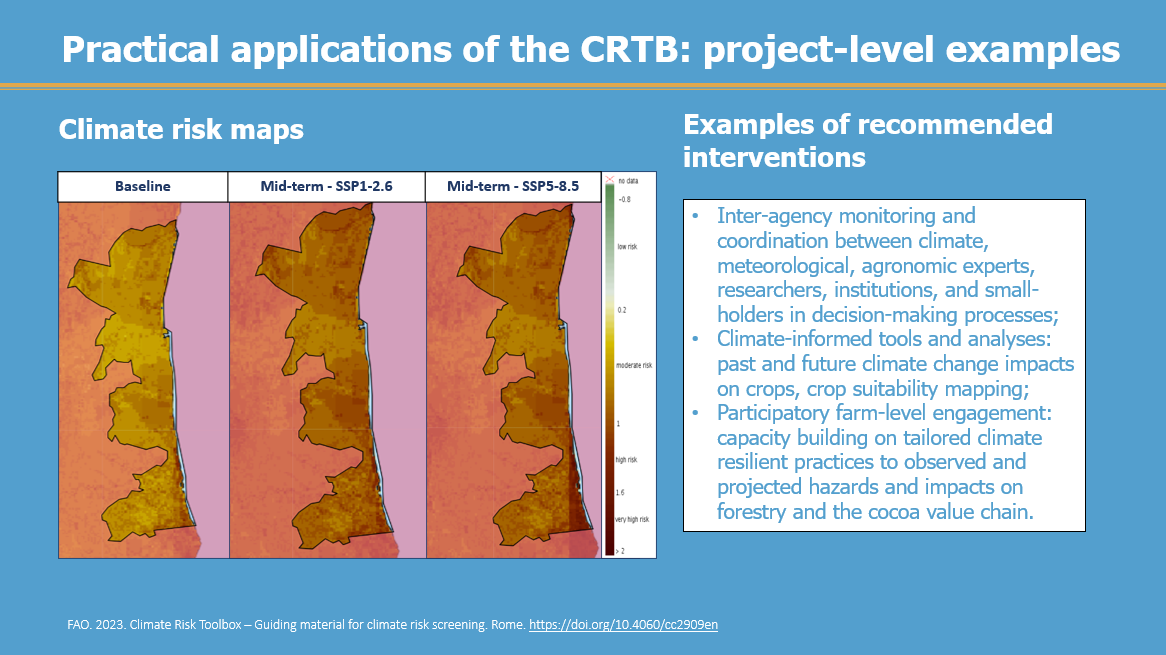➡️ Back to the IPPN group!
This blog was authored by Lev Neretin, Workstream Lead for the Environment, UN Food and Agriculture Organization (FAO) and Arianna Gialletti, Climate Risks and Value Chains Specialist, following the IPPN Knowledge Café on Climate Risk Toolbox – Designing Climate-resilient Agricultural Investments (18 January 2023). Originally posted in FAO's Climate Change portal.
Integrating climate risks into policy and programming
The Climate Risk Toolbox (CRTB) is a tool designed by the Food and Agriculture Organization of the United Nations (FAO) to support climate risk screenings and help policies and agricultural investments better account for climate-related risks.
As the effects of climate change and extreme weather become increasingly more frequent and impactful, it is crucial that policies and investments are designed with robust evidence on past and future climate variability, seasonality, and extremes.
The Climate Risk Toolbox (CRTB), hosted on the Hand-in-Hand Geospatial Platform, allows users to conduct climate risk screenings for a specific area of interest and system (crops, livestock, fisheries and aquaculture, biodiversity, and forestry) based on geospatial layers incorporating risk drivers such as hazard, exposure, vulnerability, and adaptive capacity.
The new FAO Strategy on Climate Change (2022-2031) highlights the importance of integrating climate risks into its corporate systems, programming, and policymaking. FAO has also become one of the first UN agencies to include a climate change and disaster risk reduction standard in its new Framework for Environmental and Social Management.
The CRTB promotes inclusive digitalization to trigger climate change adaptation action by scaling up knowledge sharing on climate-resilient datasets, methodologies, and tools across agri-food systems. The tool can be applied at every spatial level, from continental to country level or sub-national level to project level. A guiding material for climate risk screening using the CRTB is also publicly available.
Through the CRTB, FAO aims to simplify and optimize the process of climate risk screening by providing early detection of hazards, exposure, vulnerability conditions, and indicators of adaptive capacity. It can help identify and prioritize higher-risk countries or areas within countries during the early design stages of policy programs, by using geospatial information to understand relationships between different climatic, environmental, social, and economic layers, and providing detailed descriptions of past and future climate trends and extreme weather events.
The CRTB aims to guide the design of resilient agricultural investment projects funded by diverse international financial institutions. For instance, the climate risk framework and screening process has been extensively applied in the FAO’s Global Environmental Facility (GEF) portfolio since 2020.
In 2022, the CRTB was applied during the design stage of a FAO-GEF project targeting the conservation of the Atlantic Forest through the sustainable management of cocoa agroforestry landscapes in South-Bahia, Brazil. For each climate risk component, indicators exceeding risk thresholds were identified, and computed together to assess the level of climate risk. It was demonstrated how the project area was highly exposed to climate hazards including drought, heavy rainfall, and flooding events, through the presence of sensitive systems such as crop, grassland, forests, mangroves, and low-land areas. The level of vulnerability of the population was also determined as high due to high levels of poverty, in addition to epidemic risks and inequalities. At the same time, a high adaptive capacity, which contributed to modulate the level of climate risk to “moderate”, was demonstrated by the presence of structured weather forecast services, the access to effective infrastructure and electricity systems, as well as by existing national public measures targeting climate adaptation in the agriculture and forestry sectors.
Furthermore, as shown in the figure below, a series of climate risk maps representing baseline and future scenarios were produced to show the intra-regional differences in the level of risk. The CRTB also recommended interventions to be included in full project design to integrate climate risk management with the project activities. These included climate-focused policy and planning, data gathering of climate impacts on targeted crop and forestry systems, as well as capacity building on climate resilient practices tailored to the cocoa value chain.

As explained by Mr. Lev Neretin, FAO's Environment Workstream Lead who coordinates work on the CRTB, “it is fundamental to apply an integrated approach to climate risk management across various areas of work, including evidence-based project and policy design and implementation, environmental and social management, and the national United Nations Sustainable Development Cooperation Frameworks”. This highlights the CRTB’s relevance in supporting countries to mainstream climate risk management within the design of national policy programmes for agrifood systems, such as National Adaptation Plans (NAP), as well as the UN Common Country Analysis (CCA).
Finally, through the CRTB, FAO aims at enhancing collaboration opportunities with diverse stakeholders including UN focal points, academia, as well as climate funds, to continue providing the state-of-the-art multidimensional and comprehensive information that contributes to climate mainstreaming in the agricultural and food security sectors.
The Integrated Policy Practitioners' Network (IPPN) is a one-stop-shop for integrated policy practitioners, operating as a knowledge hub for the global community. IPPN aims to link existing efforts on SDG integration across UN agencies and beyond, and enabling cross-pollination and learning to enhance the UN System-wide capability to practice and deliver high-quality integrated policy support. IPPN is a joint effort under the auspices of the UNSDG Task Team on Integrated Policy Support.
Browse the IPPN website: https://sdgintegration.undp.org/IPPN
Join the IPPN group on SparkBlue: https://www.sparkblue.org/IPPNgroup
Sign up to receive updates about the IPPN: https://bit.ly/IPPN_Sign-up
Any questions? Drop us a line at: [email protected] or ask us anything here

Yes let us have the multi-dimensional approach, to formulate the program.
Please log in or sign up to comment.